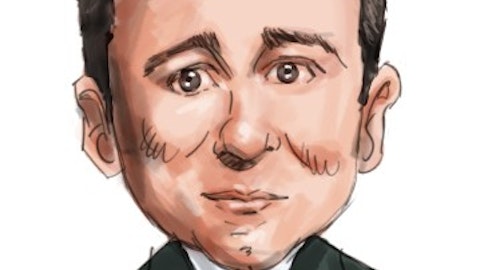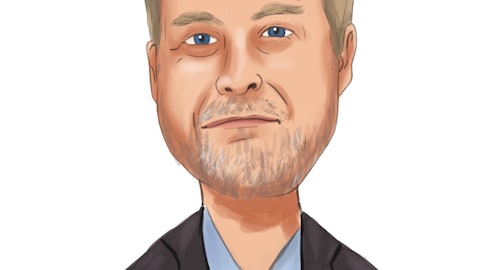Jaeme Gloyn: Yes. Thanks, good morning. My first question is what kind of tied to the performance of Clarios, it really does look like the pricing initiatives there are running well ahead of the inflationary pressures on expenses. Could you, I guess, confirm that? And then also, do you see that trend in any of the other key businesses where pricing is starting to get ahead of inflation, and we should see the kind of margin improvement that Clarios has delivered, especially in this quarter?
Denis Turcotte: Denis here. If I heard the beginning of your question right, it was related to the pricing at Clarios. And your observation is correct, pricing initiatives have started to get some traction there. And if anything, though, it’s been in effect, responding to significant price increases or cost increases as it relates to inflation, in particular, on the lead side. In general, you see that same phenomenon, right? Whenever you have rapid rises in inflationary inputs, it takes some time because, of course, customers resist, markets resist in general. So it takes a bit of time. But you’re starting to see that kick in, in a whole host of different businesses we own globally. There are always regional unique situations.
For example, in the U.K., as I’m sure all reporting issuers are commenting the markets there, the macroeconomic environment is soft. So you end up if demand is instantaneously a little bit weak, it’s a little harder to put a price increase through. But in other areas, Germany as an example of surprise to the upside. France remains strong, the U.S., in particular. You’re seeing those price increases go into as a minimum, offset inflation. We also try to focus on adjusting our product mix to provide more value to our customers so that we can get actual margin expansion as well while doing so.
Jaeme Gloyn: Okay, great. And are there any specific businesses you’d highlight as, let’s say, being at the apex of that term?
Denis Turcotte: Nothing. Like they’re all experiencing this kind of phenomenon. Again, there are always unique examples of where things go either way. With the oil and gas push, for example, our rates across the Ultera Systems are very strong and capacity utilization is improving, so pricing is improving. We’ll have little segments, for example, at DexKo, the RV trailer segment in North America, as you might imagine, in this environment is softening a little bit. So pricing is a little bit more difficult there. Having said that, steel prices have fallen significantly. So you get the cost advantage as a way of maintaining your margins even when you’re not increasing pricing. So there are unique circumstances, but on average, that’s what’s happening.
Jaeme Gloyn: Okay. Great. And second question, I suppose, for Jaspreet. Just thinking about the interest expenses and the sensitivity you provided around 50 basis points increase would lead to an increase in interest expense of about $50 million. Just thinking about the last quarter and the number of increases that we had in Q4. If rates were to stay like at the level today, how much more of an interest expense increase should we expect? So the idea is just trying to get a sense as to like how much of the rate environment that we see today is showing up in your financials at this stage?
Jaspreet Dehl: So thanks for the question. So the total interest expense for the quarter was about $249 million on our nonrecourse borrowings and then about another $20 million on our corporate RCF. So in total, about $269 million. And outside of the 25-basis point rate hike that happened in January, the Q4 interest expense is fully loaded, so it has the impact of all of the previous rate hikes and part of our book is floating and part of it is fixed. So that Q4 interest cost is fully loaded. So with the 25-basis point increase, we gave you as you noted, the sensitivity that of 50 basis points is $50 million to $25 million, it’s about a half. So we’d expect to see that increase. But I’d say on balance, what we should see this year is as we get the proceeds coming in from Westinghouse, we’ll use those to pay down our corporate borrowings, and that should lower overall interest cost for the business.
So I’d say while Q4 is fully loaded, they are higher for corporate borrowings than we’d expect for the full-year 2023. And then the other piece is Westinghouse. The interest costs were higher. So those will come out of our results once the sale closes. So I’d say on balance, I’d expect the full year 2023 to be lower than the Q4 run rate, but it will be more in the back half of the year once the Westinghouse sales closes.
Jaeme Gloyn: Understood. Got it. And last one is with the proceeds from Westinghouse coming in and correct me if I’m wrong, but it looks like the BAM preferred equity is now at the $1.5 billion. Is there an ability to repay that preferred equity down? What’s the appetite from, I guess, both sides of that piece of paper that paid down? And I guess what’s the strategy around that?
Jaspreet Dehl: So look, I can’t speak for BAM. But from our perspective, we are drawn on RCF. And as you noted, we are drawn on the preferred securities, the preferred securities are perpetual. There’s no maturity. It’s not a good rate. But there is an option that BAM has. So to ask for redemption if we have monetization. So as we get closer to the closing, we’ll have those discussions. But for now, either way at all — overall kind of lower the interest cost that we have and the preferred distribution that we’re making. Even if you add the 2 RCF and the preferred securities, getting the Westinghouse proceeds will pretty much cut it in close to half. So it will be good for the business hopefully.
Jaeme Gloyn: Good. Great, thank you very much.
Operator: And our next question comes from the line of Matthew Weekes from Industrial Alliance. Your question, please.





